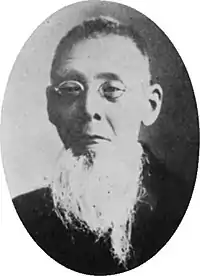Oka Rokumon
Oka Rokumon (岡 鹿門, 12 December 1833 – 18 February 1914) was a Japanese sinologist (kangakusha) of the late Edo and Meiji periods.

Biography
Oka Rokumon was born on the second day of the eleventh month of Tenpō 4 according to the traditional Japanese calendar (12 December 1833 in the Gregorian calendar).[1] He was born into a buke family in Sendai Domain.[1]
While he was still young he moved to Edo[1] and studied at the Shōhei-kō, an educational institute under the auspices of the shogunate.[1] He eventually became the director (舎長) of the institution.[1] While a student there, he developed close friendships with several of his classmates, notably Shigeno Yasutsugu, Matsumoto Keidō, Matsubayashi Hanzan and Nanma Tsunanori.[1]
In late 1861, he travelled to Kinki,[1] and while there, to help Keidō (who was not receiving a government salary),[1] planned with Hanzan to establish a school in Osaka.[1] They called the school Sōshōkō-juku (双松岡塾), literally "Two Matsus and Oka School".[1] The school became a meeting place for various figures associated with the sonnō-jōi movement, attracting negative attention from the authorities, and Oka was forced to shut the school down after less than a year.[1]
He was at this time ordered by his superiors in Sendai to perform reconnaissance work in Kyoto (the seat of the emperor and a hotbed of restorationist rebels).[1] During the Boshin War, he opposed the union of the domains of Mutsu and Dewa provinces, drawing the ire of the government, and was imprisoned.[1] Following the Meiji Restoration, he served in various government positions.[1]
After retiring early, he devoted himself to writing.[1] In 1884 he visited China, writing a travel diary recounting his experiences, Kankō kiyū (観光記遊).[1]
He died on 18 February 1914.[1] His grave is in Yūtenji in Meguro, Tokyo.[1]
Names
Rokumon was his art name.[1] His original given name was Tenshaku (天爵),[1] and his courtesy name was Shibun (子文).[1] He went by the name Keisuke (啓助) for a time,[1] and changed his name to Senjin (千仭)[1] and his courtesy name to Shin'i (振衣) at various times.[1]
References
- Andō 1983, p. 468.
Works cited
- Andō, Kikuji (1983). "Oka Rokumon". Nihon Koten Bungaku Daijiten 日本古典文学大辞典 (in Japanese). Vol. 1. Tokyo: Iwanami Shoten. pp. 468–469. OCLC 11917421.